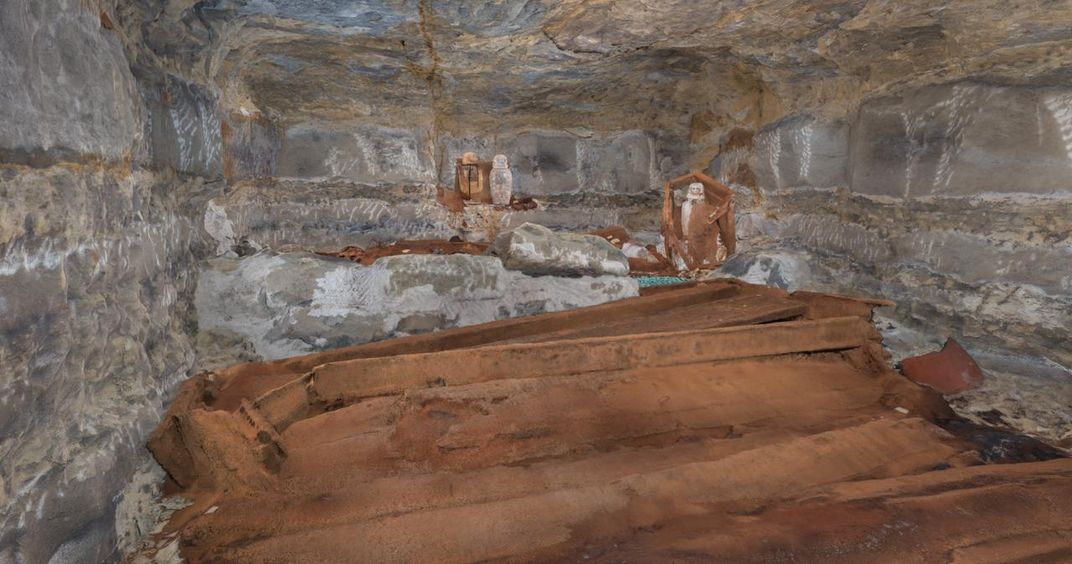Ancient Egyptian Funeral Home Reveals Embalmers Had a Knack for Business
Funeral parlors’ enterprising staff offered burial packages to suit every social strata and budget
/https://tf-cmsv2-smithsonianmag-media.s3.amazonaws.com/filer/c8/be/c8bef9f2-89f3-4c8c-bfe4-c625cb528a5b/exgxgfpwsaayl3o-1024x682.jpeg)
Known for their iconic pharaohs, pyramids and elaborate burial rituals, the ancient Egyptians were notoriously assiduous about the afterlife. It’s perhaps unsurprising, then, that they breathed new life into the bustling business of death.
Earlier this week, National Geographic released never-before-seen footage of ancient Egypt’s first known funeral home—a complex near Cairo that dates back to roughly 600 B.C., according to a press release. Discovered in July 2018, the structure offers a glimpse into the painstaking labors of mummy-making, hinting at the market-minded acumen of the entrepreneurs whose practices paved a path for future funerary rites. The findings—which represent some of the only physical evidence researchers have of embalming workshops—will feature in a new four-part series, “Kingdom of the Mummies,” premiering in the United States on Tuesday, May 12.
The researchers behind the discovery, led by Ramadan Hussein, an Egyptologist at the University of Tübingen in Germany, first hit pay dirt two years ago, when they dug into a vast, sandy shaft beneath Saqqara, a sprawling necropolis, or city of the dead, on the banks of the Nile, reports Andrew Curry for National Geographic. Expecting a tomb, the team was surprised to find what appeared to be a sophisticated mummification workshop, partitioned into dedicated areas for organ removal, embalming and burial—each with all the necessary fixings.
The chamber’s contents closely match descriptive texts commemorating the process of embalming, which took upward of 70 days to complete, per the Smithsonian Institution’s “Egyptian Mummies” webpage. After a person died, their organs were extracted and placed in jars; the rest of their remains then underwent a salt-based drying process. Finally, the body was anointed with fragrant oils, wrapped in linens studded with amulets and spells, and nestled inside of a furnished tomb.

This painstaking process more or less held for all individuals regardless of social stature. But in their final form, the remains of the rich were easy to distinguish by the luxurious and expensive accoutrements that adorned their coffins—and the goods placed in the chambers that ultimately housed their bodies. High-class organs were laid to rest in alabaster jars; fancy faces were swaddled in masks made with gold and silver. In a series of six tombs adjacent to the Saqqara funeral parlor, according to National Geographic, wealthy bodies were buried at the lowest depths, which were believed to be closest to the underworld.
The families of less well-endowed individuals still had options, though: namely, lower-budget funerary packages that shuttled their loved ones into the afterlife, albeit in slightly less style. The deceased’s innards were encased in clay, while their body was interred in a wooden coffin in the tomb’s upper tiers or simply swaddled in linen and placed in sand pits. Unable to afford masks made entirely of precious metals, middle- and working-class individuals opted for plaster versions gilded in shimmering foils, reports Sarah Cascone for artnet News.
Even the end of a burial didn’t signal the stoppage of cash flow. Patrons were also charged fees for the spiritual upkeep of the deceased—a job that employed a class of priests who dedicated their entire careers to shepherding wayward spirits and maintaining their tombs.
“Priest-embalmers were professional entrepreneurs who offered burial packages for every budget,” Hussein tells Al-Ahram Weekly’s Nevine El-Aref.
Some 50 mummies spanning several social tiers were uncovered during the excavation, offering a dazzling illustration of the ways the funeral home tailored its services to its various clientele. Among the most elaborately entombed were several elite priests and a woman buried in a seven-and-a-half-ton limestone sarcophagus, according to National Geographic.
With such enterprising offerings, funerary rites seemed not at all a dying art among the ancient Egyptians.
As Hussein says in the press release, “The evidence we uncovered shows the embalmers had very good business sense.”
/https://tf-cmsv2-smithsonianmag-media.s3.amazonaws.com/accounts/headshot/10172852_10152012979290896_320129237_n.jpg)
/https://tf-cmsv2-smithsonianmag-media.s3.amazonaws.com/accounts/headshot/10172852_10152012979290896_320129237_n.jpg)